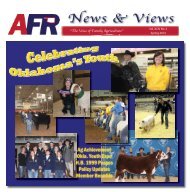Oklahoma Farmers Union - American Farmers & Ranchers
Oklahoma Farmers Union - American Farmers & Ranchers
Oklahoma Farmers Union - American Farmers & Ranchers
Create successful ePaper yourself
Turn your PDF publications into a flip-book with our unique Google optimized e-Paper software.
Cooperation, Legislation and Education<br />
“Cooperatives”<br />
Perhaps even more than legislative initiatives, the creation of cooperatives was the<br />
cornerstone for the <strong>Farmers</strong> <strong>Union</strong> organization. Initial actions to boost returns and lower<br />
expenses for producers were targeted at the creation of cooperatives and buying and<br />
marketing clubs. The debate over statehood during the early days of <strong>Oklahoma</strong> <strong>Farmers</strong><br />
<strong>Union</strong> thrust the group into legislative activity that led to key members’ involvement in<br />
writing the state constitution and being elected to the Legislature. Initially, national<br />
legislative activity took a back seat to the cooperative efforts of the organization.<br />
At the first official meeting of the re-combined Indian Territory and Indiahoma<br />
<strong>Union</strong>s which created the <strong>Oklahoma</strong> <strong>Farmers</strong> <strong>Union</strong> organization in 1905, President<br />
J.A.West, in his address before the convention, said: “Perhaps no feature of industrial<br />
organization has been so exhaustively discussed as that of co-operative warehouses. The<br />
primary principles of the union of farmers was the control of the markets. The objects to<br />
be attained were profitable prices and stable markets. Our markets have been completely<br />
in the hands of cotton exchanges, institutions which have manipulated our markets up and<br />
down, regardless of supply and demand. These institutions have destroyed the stability<br />
of the markets for all farm products, impoverished the farmer and jeopardized the<br />
business interests of the entire country.<br />
“We have adopted definite plans in the hope of destroying the mighty and<br />
tyrannical power of the Cotton Exchange. Beginning with the plan of locally bulking,<br />
which was soon followed by holding one-fourth or one-fifth of the cotton crop, and the<br />
establishment of a minimum price; but by this means, you remember we succeed in<br />
securing only partial co-operation. But through the warehouse system, we can<br />
revolutionize the present system and enthrone the farmer as absolute master in fixing the<br />
price upon his own products. The warehouse is now recognized as an indispensable<br />
addenda in stable and profitable marketing….”<br />
And so, producers envisioned controlling their own destiny through cooperative<br />
buying and selling. The principal worked as long as there was a large number of<br />
cooperating farmers and ranchers, the marketplace was more local and not a worldwide<br />
competition, and membership loyalty remained. By the late Twentieth Century, even the<br />
large merged cooperatives struggled to remain in existence. All the mergers in the world<br />
did not allow them to remain competitive in many instances with private enterprise.<br />
For the OFU organization, in 1907, membership declined from 40,000 to a few<br />
hundred because of state law interpretations allowing non-farmers to buy shares and<br />
participate in coops.<br />
Although cooperative enterprises among the membership existed almost from the<br />
get-go, during the 1920s, there were 110 cooperatives organized. Most of them were<br />
cotton gins, but many were formed into a combination of cotton gins and grain elevators.



